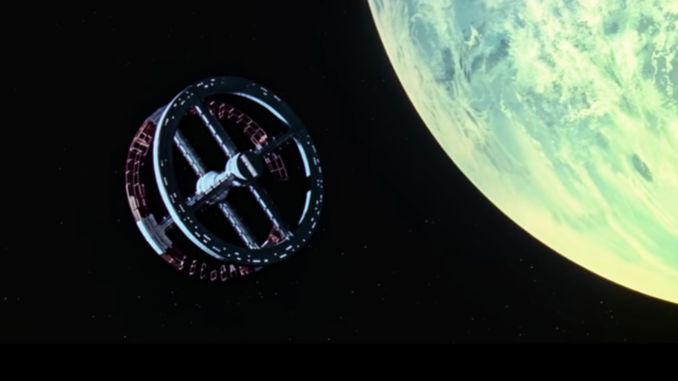
With the recent sub-orbital flights of billionaires Richard Branson and Jeff Bezos, there’ve been a flurry of articles challenging the notion of where Earth’s atmosphere ends and where space begins. Incidently, the criticism extends to mocking, roasting, and trolling the pair for spending millions of dollars in an effort to reach the cosmos but not truly making it there. Let’s countdown the contenders to see if we can come to a consensus and define the edge of space on behalf of future sky walkers everywhere.
NASA and the US military have (some would say arbitrarily) designated 50 miles (80 kilometers) as the altitude at which space begins. This chosen altitude is based in part on the calculations of Hungarian-American engineer and physicist Theodore von Kármán, who determined that a vehicle could in fact survive in Earth orbit with perigees (lowest altitude of an orbit) as low as 80-90 km. It’s said they did this in order to award X-15 pilots with astronaut wings, which seems fair, considering the technologies of the 1950s and early ’60s, though the official stated reason is to ensure equality between military and civilian astronauts who may find themselves serving on the same flight mission.
The Fédération Aéronautique Internationale (FAI) took it upon themselves in the sixties to define space to begin at 100 kilometers (62 miles / 330,000 feet) above mean sea level. They christened that altitude as the Kármán line, in honor of Theodore von Kármán (same dude that worked with NASA and the USAF above). His theoretical calculations showed in 1957 that 275,000 ft (84 kilometers) was the point at which an aircraft stayed aloft due more to its high rate of speed as it neared orbital velocity and less on lift. The air at that altitude is so thin that airflow across the wing creates only a small percentage of lift relative to the lift created at sea level. But how did the Kármán line become 100 km instead of 84 km? Well, it’s complicated but it can probably be summed up simply as international politics and the fact that people everywhere gravitate towards nice round numbers.
Another reason why 100 km was ultimately chosen by the FAI is that it is approximately where the turbopause can be found. Below the turbopause, oxygen, nitrogen, and other atmospheric gases are well-mixed, i.e. they coexist in consistent ratios. Above the turbopause, gases are not well-mixed: heavier molecules are found at lower altitudes and lighter molecules rise to higher altitudes. This is called gravitational separation.
By the way, note that on other planets the Kármán line would be set at a different altitude than it is for Earth. Planetary mass, atmospheric pressure, and having a different mix of gases would be some of the factors that would need to be taken into consideration. For example on Mars, the Kármán line has been calculated to be approximately 80 km (50 miles) but on Venus it would be around 250 km (160 miles).
Then there’s the geocorona, for those who believe that 100 km is just too constricting. A satellite belonging to the European Space Agency ESA and NASA, called the ESA/NASA Solar and Heliospheric Observatory (SOHO) collected data showing that the true size of Earth’s gaseous layer extends as far as 630,000 km outward. That’s 50 times Earth’s diameter. The geocorona is a cloud of hydrogen atoms that are tickled by the Sun, such that the cloud is elongated away from Sol, very much like the tail of a comet, and the Moon passes through this tail monthly. Do we need to travel outside of this cloud to be in space proper?
Let’s not forget the exosphere, the highest – and thinnest – layer of Earth’s atmosphere. Scientists disagree on where the exosphere ends and ‘pure’ space actually begins. At the very least, it extends out to 190,000 km (120,000 miles), only half the distance to the Moon. But the debate rages on.
Here’s an outstanding video from Seeker (all their videos are top notch and this one is sure to cover anything I left out above) arguing correctly, in my opinion, that…
… “No Human Has Ever Left Earth’s Atmosphere, Here’s Why” (5:10):
There is no internationally accepted definition of where space begins. Governments don’t agree. Space agencies don’t agree. Scientists don’t agree. You could come up with your own rationalized definition of where space begins, and you wouldn’t be wrong because there is no universal definition.
Now I’ll throw my two cents into the ring. There are always multiple ways of looking at anything and here I’ll present a very different way of looking at the question of where space begins. One could look at Earth and its entire atmosphere extending hundreds of kilometers out into the void, or only consider the first fifty miles. No matter how many (or how few) layers of the atmosphere one considers, when viewed from far away, say Mars, or Pluto, or Alpha Centauri, Earth’s atmosphere is very, very thin and fragile.
In the vast region between Mars and Pluto, traces of oxygen, nitrogen, and other atmospheric gases can be found. These seeds, sown by comets, are collected by Earth’s gravity well, replenishing our atmosphere. So tell me, other than density, what is the difference between the space occupied by trace gases out in our solar system, and the space occupied by our much denser collection of gases that provides us air to breath. After all, one could observe that both are in space. In fact, one could observe that Earth is in space. Buckminster Fuller called it “Spaceship Earth”, as he recognized that we all are already in space and travelling through space together.
Question Of The Night: Who else wanted to be an astronaut when we were kids?
